Gymnopus androsaceus (L.) J.L. Mata & R.H. Petersen - Horsehair Parachute
Phylum: Basidiomycota - Class: Agaricomycetes - Order: Agaricales - Family: Marasmiaceae
Distribution - Taxonomic History - Etymology - Identification - Culinary Notes - Reference Sources
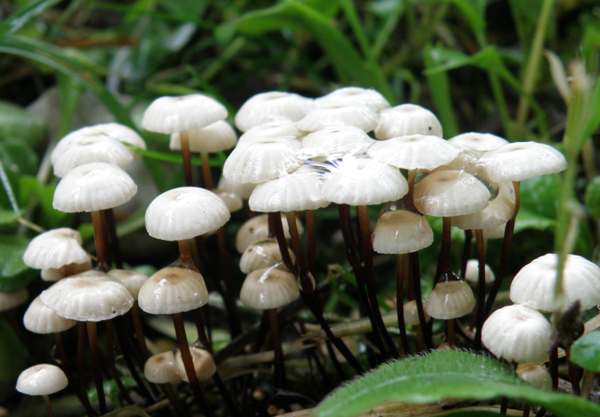
There is little obvious difference between this tiny mushroom and the Collared Parachute, Marasmius rotula until you glance beneath the cap, but then you will see that the gills of the Horsehair Parachute are attached directly to the stem and not to a collar. Other distinguishing features are the remarkably long stem in comparison with the size of the cap, and fine horsehair-like threads of densely interwoven mycelium extending outwards from the stem base in search of new substrate material to colonise.
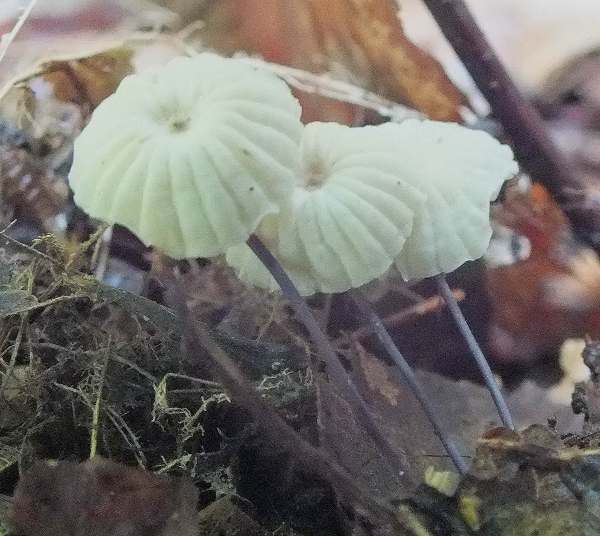
Distribution
A fairly common find in Britain and Ireland, Gymnopus androsaceus occurs throughout mainland Europe as well as in many parts of Asia and North America. They may be small but these little mushrooms know how to swarm, and often they occur not singly but in groups of five to fifty fruitbodies.
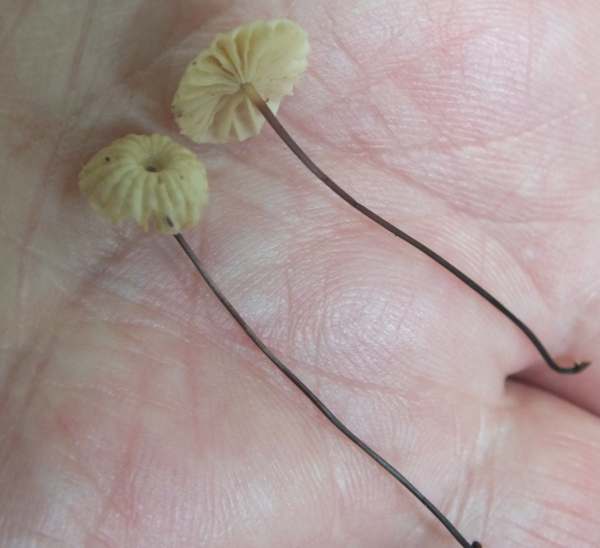
Taxonomic history
The species was described in 1753 by Carl Linnaeus, who gave it the binomial name Agaricus androsaceus. (In the early days of fungal taxonomy most gilled fungi were initially placed in a giant Agaricus genus, now largely redistributed across many other genera.) It was a recently as 2004 that this species was renamed Gymnopus androsaceus, as a result of work published by American mycologists Juan Luis Mata and Ronald H Petersen (b 1934).
Gymnopus androsaceus has several synonyms including Agaricus androsaceus L., Merulius androsaceus (L.) With., Marasmius androsaceus (L.) Fr., Androsaceus androsaceus (L.) Rea, and Setulipes androsaceus (L.) Antonín.
Etymology
Gymnopus, the generic name, comes from Gymn- meaning naked or bare, and -pus meaning foot, stem or stalk; hence, bare-stemmed is the implication. The specific epithet androsaceus comes from andros- meaning a tiny plant or herb, plus the suffix -aceus which has many interpretations including 'with the quality (or colour) of', or 'closely resembling', or even more loosely 'relating to'. Thus androsaceus can be interpreted as 'looking very much like a tiny plant' - and we must remember that mushrooms were considered to be plants when Carl Linnaeus was naming the Horsehair Parachute.
Identification guide
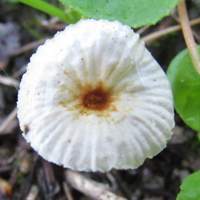 |
CapConvex initially, flattening with a depressed centre at maturity; dry, smooth, radially grooved and wrinkled; 0.4 to 1cm across. Pinkish buff in the centre but usually much paler towards the margin (occasionally almost pure white). |
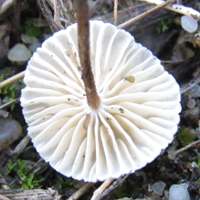 |
GillsAdnate; distant; pinkish-buff, turning ochre when old. StemVery thin, tough and wiry, smooth; 2.5 to 5cm long and 0.5 to 1mm in diameter; reddish brown near the apex; very dark brown or black below; no stem ring. |
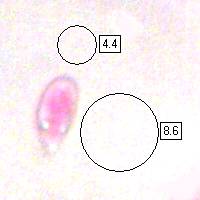 |
SporesEllipsoidal or less commonly dacryoid (tear-drop shaped), smooth, thin-walled, 6.5-9 x 3.5-5μm, with a prominent hilar appendage; hyaline; inamyloid.
Spore printWhite. |
Odour/taste |
Not distinctive. |
Habitat & Ecological role |
On dead wood, usually from deciduous hardwood trees. |
Season |
June to November in Britain and Ireland. |
Similar species |
A similar species Marasmius rotula, known as the Collared Parachute, has its gills attached to a collar that surrounds the stem. |
Culinary Notes
This little mushroom is generally regarded as inedible. In any case it is far too insubstantial to be of any culinary value, and so we have no recipes for soups or other mushroom dishes based on this species.
Reference Sources
Fascinated by Fungi, 2nd Edition, Pat O'Reilly 2016, reprinted by Coch-y-bonddu Books in 2022.
Dictionary of the Fungi; Paul M. Kirk, Paul F. Cannon, David W. Minter and J. A. Stalpers; CABI, 2008
Taxonomic history and synonym information on these pages is drawn from many sources but in particular from the British Mycological Society's GB Checklist of Fungi.
Fascinated by Fungi. Back by popular demand, Pat O'Reilly's best-selling 450-page hardback book is available now. The latest second edition was republished with a sparkling new cover design in September 2022 by Coch-y-Bonddu Books. Full details and copies are available from the publisher's online bookshop...


